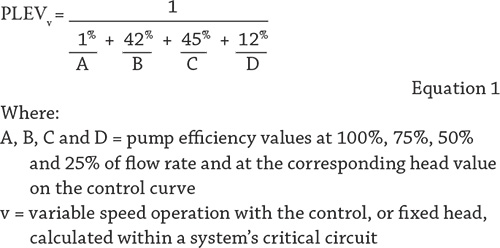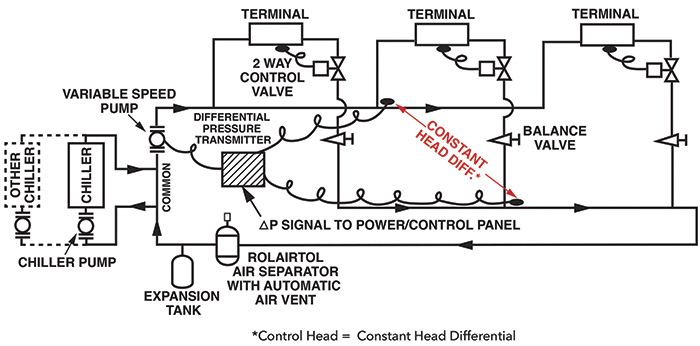With an ever-greater focus on sustainable and energy-efficient building design, right-sizing a building’s heating, ventilation and air conditioning (HVAC) system’s components is growing in importance by providing a significant opportunity to achieve project performance goals. Detailed analysis of a building’s heating and cooling loads helps ensure selection of the proper equipment for a system, while maximizing efficiency and minimizing operating costs.
However, system components are not always sized correctly. General industry practice leads to equipment selection that is oversized because HVAC designers often size equipment based on a system’s design load or maximum capacity.
Using this outdated approach, pump system efficiency typically is measured at 100 percent load conditions, even though the system generally operates at that level only during 1 percent of its yearly operation. Flow requirements fluctuate constantly throughout the year based on a building’s heating or cooling load at any given time. As a result, centrifugal pumps installed in HVAC systems operate most of the time at part-load conditions.
By applying a specification formula that accounts for variations in load profile, HVAC designers have the tools needed to select pumps based on real-world system demands to ensure the most efficient system performance. Called the Part Load Efficiency Value (PLEV), the calculation accounts for the entire variation profile and flow requirements based on the actual heating or cooling load in a commercial building HVAC system, not just the best efficiency point (BEP).
PLEV comes from the successful Integrated Part Load Value (IPLV) performance calculation developed by the Air-Conditioning, Heating, and Refrigeration Institute (AHRI) in AHRI 550/590-1998. The IPLV formula describes the equipment efficiency while operating at various capacities of a chiller system, and it is crucial in supporting energy use and operating costs throughout the system’s lifetime.
Because of its wide acceptance by chiller makers as a baseline comparison between manufacturers, similar correlations can be adopted for centrifugal pumps used in heating and cooling systems.
 Equation 1 shows the method for calculating PLEV. In the equation, A, B, C and D represent pump efficiency values. Based on the equation, during any given year the pump will operate at 100 percent flow (duty point) only 1 percent of the year; 75 percent flow 42 percent of the year; 50 percent flow 45 percent of the year; and 25 percent flow 12 percent of the year.
The subscript “v” denotes variable speed operation with the control, or fixed head, calculated within a system’s critical circuit. Selection software that includes the PLEV calculation defaults to 30 percent of pump total design head (TDH) to represent the minimum control head within a system.
The American Society of Heating, Refrigerating and Air-Conditioning Engineers (ASHRAE) 90.1-2013 guideline requires that the total head loss in a system be calculated, making it natural to also calculate the critical zone’s fixed head. This is the number that should be used because it represents a more accurate calculation, which will be reflected in the cost analysis.
Most heating and cooling systems are closed loop and require a constant head differential at all times. The constant head differential is necessary for system control and to ensure that the necessary differential head across any controlled subcircuit is maintained during operation.
PLEV can be used to accurately compare pumps from different manufacturers to identify overall operational efficiency. The 30 percent of TDH—or calculated minimum control head within the equipment schedule along with specifications—will ensure a fair “apples to apples” comparison among manufacturers.
Equation 1 shows the method for calculating PLEV. In the equation, A, B, C and D represent pump efficiency values. Based on the equation, during any given year the pump will operate at 100 percent flow (duty point) only 1 percent of the year; 75 percent flow 42 percent of the year; 50 percent flow 45 percent of the year; and 25 percent flow 12 percent of the year.
The subscript “v” denotes variable speed operation with the control, or fixed head, calculated within a system’s critical circuit. Selection software that includes the PLEV calculation defaults to 30 percent of pump total design head (TDH) to represent the minimum control head within a system.
The American Society of Heating, Refrigerating and Air-Conditioning Engineers (ASHRAE) 90.1-2013 guideline requires that the total head loss in a system be calculated, making it natural to also calculate the critical zone’s fixed head. This is the number that should be used because it represents a more accurate calculation, which will be reflected in the cost analysis.
Most heating and cooling systems are closed loop and require a constant head differential at all times. The constant head differential is necessary for system control and to ensure that the necessary differential head across any controlled subcircuit is maintained during operation.
PLEV can be used to accurately compare pumps from different manufacturers to identify overall operational efficiency. The 30 percent of TDH—or calculated minimum control head within the equipment schedule along with specifications—will ensure a fair “apples to apples” comparison among manufacturers.
 Figure 1. A typical closed loop HVAC system. Constant head differential must be maintained at all times. (Graphic courtesy of Bell & Gossett)
Figure 1. A typical closed loop HVAC system. Constant head differential must be maintained at all times. (Graphic courtesy of Bell & Gossett)
